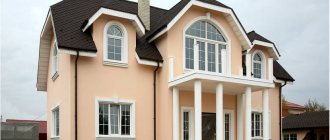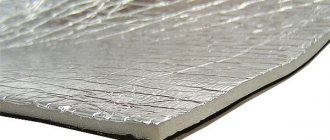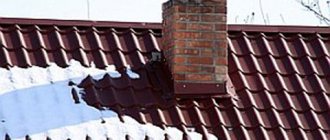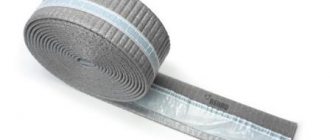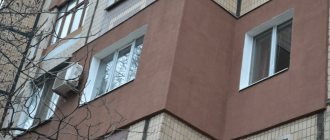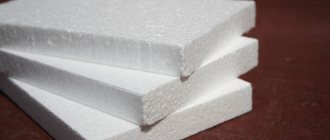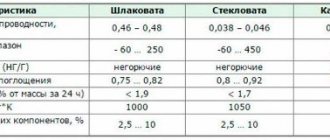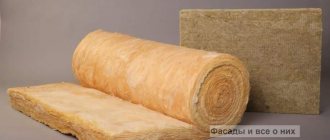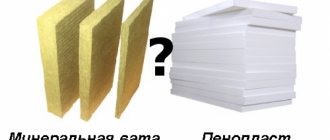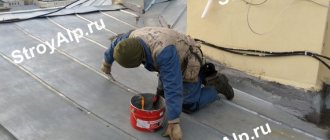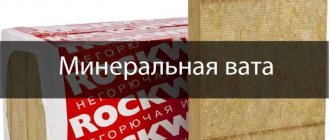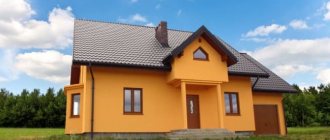Is it better to do a wet façade before winter?
First of all: why should these options be avoided?
A wet façade is a thermal insulation material (basalt wool or PPS) fixed to the façade wall using adhesive (usually) or mechanically (less often) methods. The top of the slabs is reinforced with fiberglass mesh and plastered. Ordinary plaster is painted or covered with ceramic tiles. The decorative one is self-sufficient, but it can also be painted if desired.
The advantages of this technology are a relatively low price, many design solutions (the ability to give the house an individual look), there are no problems during restoration, space saving in the house - the thermal insulation properties of the cladding depend on the thickness of the insulation, there is no need to take additional insulation measures from the inside.
Important There are also disadvantages. One of them is climatic restrictions during installation.
What materials are used to insulate a house in winter?
Among the many building materials, builders prefer the following insulation materials:
- expanded clay. It is a lightweight, porous granule produced by firing clay at high temperatures. The peculiarity of expanded clay is its environmental friendliness. It is harmless to others. The material is resistant to negative temperatures and is used for thermal insulation of buildings;
- polystyrene foam This thermal insulator is popular in the construction industry. Carrying out work using it does not require increased costs due to the low cost of polystyrene foam. The material is securely attached to the base with glue and holds well due to its low weight. Weaknesses - damage by rodents and fire hazard;
- mineral wool. This is a traditionally used insulation. Provided that it is installed correctly and is reliably protected from moisture absorption, it can provide thermal insulation for a room. When performing thermal insulation measures in the basement part of the building, moisture insulation of mineral wool should be ensured;
- penoplex. This material is also known as expanded polystyrene. It is characterized by a long service life, environmental friendliness, and reduced hygroscopicity. The strength properties of penoplex are much higher than those of polystyrene foam. The heat insulator has low thermal conductivity and high resistance to natural factors.
In terms of efficiency, the external thermal insulation of a house is superior to the internal one
. When thinking about using an effective thermal insulator, you should take into account the performance characteristics and properties of building materials:
- specific gravity. Thermal insulation properties increase with decreasing density;
- ability to conduct heat. Thermal conductivity is characterized by a special coefficient;
- breathability. The structure of the material must allow the escape of moist air;
- resistance to open fire. Fireproof materials allow you to avoid problematic situations;
- frost resistance. Does not allow the insulation to crack when the volume of moisture increases as a result of freezing;
- strength. To maintain integrity under mechanical loads, increased strength properties are required;
- moisture resistance. To use insulation in areas with increased humidity, water resistance is important;
- duration of operation. The use of durable thermal insulators reduces the cost of building repairs.
The given characteristics are the main ones. However, a number of properties should be taken into account:
- ease of cutting for installation;
- damage by mice;
- sound insulation level;
- fixation method;
- harmlessness to others;
- convenience of delivery.
By comprehensively assessing the performance characteristics of building materials, you can make the right decision.
Insulation protects the room from cold penetration
At what temperature should a wet façade be installed?
The construction of a wet facade in winter is complicated by the presence of water in the adhesive and plaster solutions. The freezing point of water is 0 degrees. There is relatively little of it in solutions, so they are functional even below zero, but within certain limits.
When asked at what temperature to install a wet façade of a building, most experts answer: up to minus five. Below this, dehydration stops, i.e. the plaster will not harden.
Have questions? Call, Ask! +7
Or write to us Ask a question
How to make a wet facade in sub-zero temperatures?
One of the “folk” remedies - adding salt to the solution - does not stand up to criticism: during the installation process and immediately after its completion, the cladding looks good and retains heat, but when it starts to warm up outside, salt stains appear on the facade.
To make a high-quality wet facade in winter, the technology is as follows: a temporary heat-insulating contour is formed.
Procedure:
- Construction of forests. They are usually erected in the summer; there are no fundamental differences from standard conditions.
- A waterproof film is stretched around the outer perimeter and special thermomats are installed.
- Heating devices - coal, gasoline, electric - are installed in the work area. Experts do not recommend diesel heaters: the soot formed during operation settles on the thermal insulation material and can impair its adhesion to the covering layer.
Thus, its own microclimate is formed under the film. To apply decorative plaster, you need to maintain a working temperature of + 8 degrees; for the remaining stages of the process, plus five is enough.
In professional jargon, this circuit is called a “warm”. In addition to the fact that it creates suitable conditions for work in any season, it has other advantages:
- insulation from precipitation;
- UV protection;
- from the wind;
- from high humidity.
During construction, all indicators are maintained at the same level, which cannot but affect the quality of the finished facade. To some extent, the warmer also provides ease of work: you don’t have to go downstairs to get a dropped tool.
The method is used not only for wall cladding, but also for masonry, conventional insulation, restoration, roofing and other external work. Its disadvantages are obvious: increasing price, duration and complexity of the process. The cost of the facade increases by about 10 percent.
Examples of our work
Finishing of the facade in the Gar-Pokrovskoye community center
Finishing of the facade in KP Babenki
Finishing of the facade in the village of Firsanovka, Moscow region
Facade finishing in Antonovka
Internal thermal insulation of a wooden structure
Internal thermal insulation of a house does not require significant financial costs compared to external insulation. However, it cannot provide reliable protection of walls and foundations from freezing. For insulation, expanded clay granules, mineral wool, and sheet materials are used.
You can also insulate the foundation from the inside. This can be done by simply covering the basement walls with insulating material.
The use of expanded clay granules for insulation
For internal insulation, expanded clay is used to solve the following problems:
- thermal insulation of the underground part of the base;
- insulation of the space located under the floor.
The technology for insulating the base with expanded clay involves the following work:
- Formation of a moisture-wicking pillow.
- Filling with expanded clay granules.
It is important to provide air space under the floor to ventilate the material and remove moisture.
Thermal insulation of the base of the house with mineral wool
It is possible to use mineral wool for thermal insulation on the inside of the building. Procedure for insulation with mineral wool:
- Create cavities at the bottom of the walls to drain condensate.
- Provide waterproofing protection.
- Lay and fix the mineral wool.
- Protect the outer surface of the insulation from moisture.
It must be remembered that the material is prone to absorbing moisture and requires reliable waterproofing.
Using Modifiers
Recently, many modifying additives have been invented, including those that increase the frost resistance of building materials. What are they and at what temperature is a wet façade made using them?
Frost resistance is increased by eliminating water as a component of the solution. The binding component is made using acrylic modified at the molecular level.
For your information
This composition not only allows work to be done in cold weather (down to -15 degrees), it can also be stored in cold conditions.
Some experts are skeptical about the manufacturers' optimistic promises. Their arguments also cannot be discounted:
- firstly, the processes of crystallization of frost-resistant compositions are not well studied; repeated testing and verification in practice is required;
- secondly, the use of modifiers can cause a number of side effects, leading to changes in the quality characteristics of the finished facade, reducing its durability, worsening thermal insulation properties, etc.
Selection criteria and types of winter insulation
For a long time, expanded clay concrete and foam concrete served as the main materials for insulating facades in winter. Then glass wool began to be used, and only with the development of construction technologies did many other materials appear that cope well with thermal insulation. Each material has its own characteristic advantages that determine their choice.
- Mineral wool. Excellent for insulating facades. It has many advantages: fibrous structure, high vapor permeability, non-flammability, and it is inexpensive. The facade insulated with mineral wool is able to “breathe”, which prevents the formation of fungus and mold. The material is suitable for all types of structures. Mineral wool is mainly used in “dry” processes.
- Expanded polystyrene. It is one of the most budget-friendly materials for insulating facades. It is light, airtight, and easy to work with. In parallel with its advantages, the material has a number of disadvantages. When exposed to sunlight, it ages, so it needs to be covered with primer, paint or cladding. Due to the fact that foam plastic does not allow air to pass through well, it cannot be used for thermal insulation of wooden houses.
- Thermal panels. The material performs two functions at once: cladding and thermal insulation. Design and content may vary. Minslabs, polystyrene foam, cellulose, etc. can be used as an insulating layer, and decorative plaster, metal, metal-plastic can be used as a cladding. The design can be assembled in the form of puzzles and conventional fastenings with self-tapping screws.
- Warm paint. Initially, the material was intended for use in the space sector, but over time it became in demand in construction. It's all about filling the paint. It contains microscopic glass spheres, inside of which there is a rarefied space. The binding elements are latex, acrylic, silicone or a mixture of them. A 1 mm layer of paint is enough to provide protection as much as 2.5 cm from mineral insulation.
- Izolon (foamed polyethylene). Available in soft rolls several millimeters thick. Often used in “dry” processes. Acts as a supplement to the main insulation of the facade with foam plastic in winter. Foamed polyethylene can be mounted anywhere in the frame: on the wall or under the sheathing. Isolon is vapor-proof and should not be used in the same structure with mineral wool.
When choosing a material for facade insulation, pay attention to the type of structure, region of residence, insulation properties and your financial capabilities. But it is best to consult with specialists who will determine exactly which thermal insulation option is suitable in a particular case.
Is it possible to leave an unfinished wet façade in winter?
A reasonable question: if winter cladding is associated with difficulties, is it not possible to somehow preserve what has been started before the onset of warmer weather?
Plaster performs not only a decorative function. First of all, it protects the insulation from atmospheric influences. Expanded polystyrene is sensitive to ultraviolet rays and should not be left in direct sunlight for long periods of time (even in winter). The water absorption of PPS is minimal, but it still exists. Over a long period of time, the insulation will become thoroughly wet. Second: PPS is flammable. If you leave it open, you will have to take fire safety measures.
Basalt wool is a non-flammable material, but its hygroscopicity is very high. Wet insulation loses half of its basic qualities. The influence of mechanical factors on any material in winter also increases - wind, precipitation.
Important
From all this it follows that it is extremely undesirable to fix the insulation and leave the facade like that for the whole winter.
The option of covering the walls with plastic film does not inspire confidence either - the film does not breathe, condensation will accumulate under it. There are special “breathable” hydro-windproof membranes, but on the scale of an entire facade this will be expensive.
It is advisable to at least reinforce the slabs before the onset of cold weather, apply a covering layer of plaster and prime them with a frost-resistant, water-resistant compound. Can be coated with primer paint containing acrylic sand. Leave decorative finishing until spring.
It should also be taken into account that it is recommended to apply decorative plaster to the walls after the house has settled, this prolongs its service life. If a wet facade is being carried out on a newly built house, a forced break can benefit the structure.
Are you planning to decorate the facade? All you have to do is call, and then we will do everything ourselves!
+7
Multiline phone
Ventilated facade
Installing a ventilated façade during the cold season is the best option for thermal insulation. The structure is a rigid frame attached to a load-bearing wall, insulation and cladding. The subsystem is designed in such a way that there is a gap between the facing material and the thermal insulation where air circulates. These flows remove all excess moisture from the insulation and ensure its long service life.
Ventilated façade installation is carried out in any weather. Today there are many different ventilation facade design options on the market for different facing materials. The main steps look like this:
- Installation of brackets to a load-bearing wall;
- Construction of a heat-insulating layer;
- Installation of a windproof membrane;
- Installation of guides;
- Installation of cladding.
The cladding is selected by the customer before selecting the ventilation façade subsystem.
